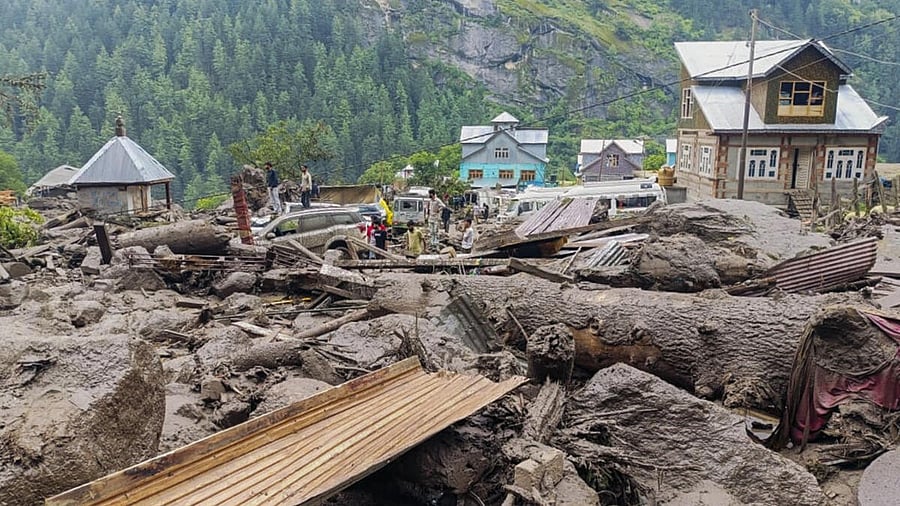
People move through the debris after a massive cloudburst at Chasoti village, in Jammu and Kashmir's Kishtwar district, Thursday, Aug. 14, 2025.
Credit: PTI Photo
Srinagar: At least 40 people, including two CISF jawans, were killed and over 120 injured after a massive cloudburst struck Chositi village in Jammu and Kashmir’s Kishtwar district on Thursday afternoon, unleashing flash floods and large-scale destruction along the Machail Mata Yatra route, officials said.
More than 200 people are still missing as rescuers battle hostile terrain to reach survivors, they said. The disaster occurred between 12 noon and 1 pm, when torrential rain suddenly pounded Chositi — the last motorable point before the shrine — sending walls of water, rocks, and debris cascading through the narrow valley.
The annual Machail Mata Yatra has been suspended indefinitely as authorities mobilised all available resources for rescue and relief operations. Personnel from the State Disaster Response Force (SDRF), National Disaster Response Force (NDRF), Army, and local police have reached the area, reports said.
Additional reinforcements and medical teams are on standby, but the remoteness of the location and washed-away approach roads have slowed the inflow of confirmed updates. Helicopters have been pressed into service to ferry critically injured pilgrims to district hospitals, reports added.
“Rescue teams are on the ground, but the terrain is extremely challenging. We are focusing on evacuating survivors and providing immediate medical aid,” a senior official said.
Videos from the site show panic-stricken pilgrims being hurriedly evacuated from the yatra’s starting point and makeshift camps being flattened by the gushing waters.
Rescue agencies have warned that the toll is likely to rise as debris is cleared and more areas become accessible. “We are racing against time to find survivors. Every minute counts,” an SDRF officer involved in the operation said.
Cloudbursts — sudden, extreme rainfall events over a small area — have caused devastation in Jammu and Kashmir several times in recent years. In July 2021, a cloudburst in Hunzar village of Kishtwar’s Dachhan area killed 26 people and left 17 injured.
In July 2022, a cloudburst near the Amarnath cave shrine killed 16 pilgrims and injured over 40. In July 2017, Thathri town in neighbouring Doda district was hit, killing at least six. The Kashmir Valley’s worst flood in September 2014 was triggered in part by a cloudburst, submerging Srinagar and claiming more than 200 lives.
Elsewhere in India, cloudbursts have repeatedly struck the Himalayan belt — including Uttarakhand’s Kedarnath disaster in 2013, which killed thousands, and Leh in 2010, when over 200 people died.
Experts say J&K’s steep mountains, fragile slopes, and narrow river valleys make it particularly prone to flash floods triggered by cloudbursts. Climate change has intensified erratic weather patterns, increasing both the frequency and severity of such events.
Rapid, unregulated construction in ecologically fragile zones — including along pilgrimage routes — has further weakened natural drainage systems, heightening disaster risks. Large gatherings for religious yatras in remote areas compound the vulnerability, as emergency evacuation becomes difficult once calamity strikes, experts believe.